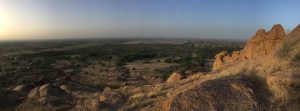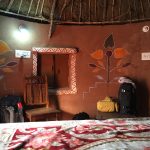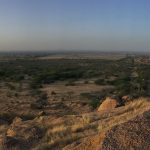Feb 22. Two days ago we flew from Cochin International Airport to Delhi and on to the town of Jodhpur in Rajasthan where we were picked up by Shambu, the second-oldest son of Chottaram Prajabat, owner of a homestay and weaving business in Salawas village catering to foreign tourists. We are here courtesy of Carpediem Residency, an artists and writers residency run by film-maker Shivajee Chandrabhushan and his wife Triparna Banerjee. Shivajee is the director and producer of “Frozen” (2007), a prize-winning independent film. Triparna was among the first group of script writers for the Indian version of Sesame Street. She works with a group called Pop-up Talkies that brings Indian independent films to non-traditional venues across the country, among other things. Miriam and I share the residency with Johanna, a novelist and documentary film-maker from Finland, Moksha (a Pratt-trained painter from Mumbai), Pat and Lukas from Valencia (she is Spanish, he is German; Pat does fine-arts, Lukas composes and arranges techno-music for theater), and Filipa (a painter from Portugal who currently lives and studies in Tokyo).
It is too early to say much about Rajasthan or life in Salawas Village, but it strikes us as very different from Kerala. Kerala is green, the people are highly educated even in rural areas, and there is a degree of equality between the genders, at least historically and in comparison with North India. Jodhpur is in the desert, the village is dusty and monochrome, people are poor and less educated, the first impression is less hospitable in nature and culture. Married women veil themselves in the presence of their in-laws, but the logic of veiling or not may also be affected by our presence. People on the street stare at us and don’t necessarily return our greetings. Many children are out and about (some young ones naked) and they accost us with calls of “one pen” or “selfie” or gawk at us as incuriously as some of the grown-ups. None of this was the case in Kerala where, when you met someone’s gaze, they would invariably smile and recognize you with their characteristic head-waggle.
Our hosts are part of a clan that has friends and foes in the village. We were told (by the teenage son) only to shop at stores that are part of this network of families and avoid the others. When we walk around we feel we’re on a stage, exposed, seen as not classifiable other than potential sources of money.
The second day of walking around (just Miriam and I) mitigated our first impressions. A young woman invited us into her house and showed us around with pride and without ulterior motives, much as we were treated in Kerala.
Our little group is still finding itself. Miriam had hoped to replicate her experience from the three weeks at the Palette People residence, but everything is different here and we will have to figure out how best to use our time. We have two weeks.
- Living in guest huts.
- Looking east from "Hanuman" sanctuary, Salawas village.



